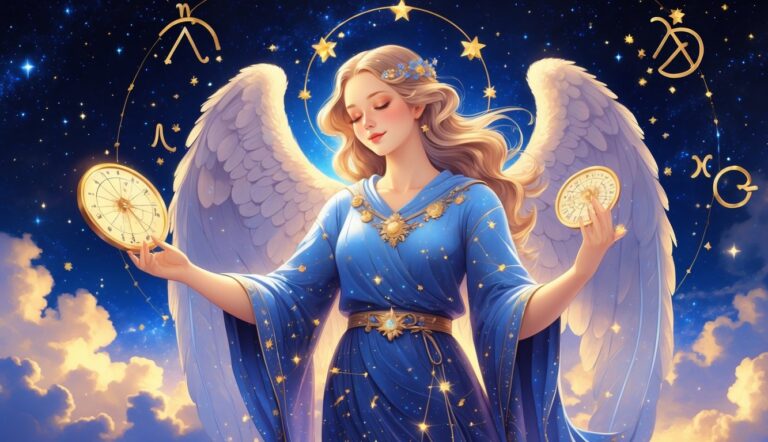Align Your Life with Your True North
The Power Quadrant System decodes your natural talents and pinpoints the career, timing and relationships that let you earn more, love deeper, and wake up eager for the day.
- Uncover your #1 high-income strength
- Draw in partners who raise your energy
- Work when your body’s clock is in “flow”
Curious about the Rider Waite Tarot deck? You’re not alone.
This iconic set of 78 cards has captivated readers and mystics for over a century.
A.E. Waite created the deck in 1909.
He collaborated with artist Pamela Colman Smith to bring his vision to life.
The Rider Waite deck’s rich symbolism and vivid imagery make it an ideal starting point for beginners and a treasured tool for experienced readers alike. Each card tells a story, weaving together ancient wisdom, esoteric traditions, and universal archetypes.
From the mysterious High Priestess to the jovial Sun, these cards offer a window into the human experience and the mysteries of the universe.
Whether you’re looking to dive into tarot reading, explore spiritual symbolism, or simply appreciate beautiful artwork, the Rider Waite deck has something to offer.
Its enduring popularity speaks to its power to inspire, enlighten, and spark the imagination.
Ready to discover the secrets hidden within these 78 cards?
Origin and History
The Rider-Waite Tarot deck emerged in the early 20th century, revolutionizing tarot card design and interpretation.
Its creation marked a significant shift in tarot’s accessibility and popularity.
Decode Your Personal Success Blueprint
Power Quadrant System shows you the exact career, relationships, and daily rhythm that match your natural DNA—so you earn more, work happier, and connect deeper.
- Pinpoint your #1 money-making talent
- Erase conflict & attract ideal partners
- Multiply productivity with perfect timing
Creation and Design
Arthur Edward Waite, a prominent occultist, conceived the idea for a new tarot deck in 1909.
He collaborated with artist Pamela Colman Smith to bring his vision to life.
Both were members of the Hermetic Order of the Golden Dawn, an influential occult society.
Waite aimed to create a deck that was more intuitive and symbolically rich than existing ones.
Smith’s illustrations brought depth and narrative to each card, making them easier to interpret.
The deck was first published in 1910 by the Rider Company, hence the name “Rider-Waite.”
Unlike previous decks, the Rider-Waite featured fully illustrated scenes for all 78 cards, including the Minor Arcana.
This innovative approach made the deck more approachable for beginners and added layers of meaning for experienced readers.
Popularity and Cultural Impact
The Rider-Waite Tarot deck quickly gained popularity, becoming a standard in the English-speaking world.
Tap Into Your Built-In Success GPS
The Power Quadrant System deciphers your genetic blueprint so you can lock onto the career, income and relationships that feel effortless—and wildly rewarding.
- Zero in on your natural high-earning genius
- Sync with partners who boost your vibe
- Wake up driven, finish days fulfilled
Its influence extended far beyond its initial release, shaping how tarot is practiced and understood today.
You’ll find the Rider-Waite’s imagery replicated or referenced in countless modern decks.
Its symbolism has become deeply ingrained in tarot culture, serving as a foundation for new interpretations and designs.
The deck’s accessibility helped demystify tarot, making it more appealing to a broader audience.
It’s often recommended for beginners due to its clear imagery and wealth of symbolic detail.
Today, the Rider-Waite remains one of the most widely used tarot decks globally.
Its enduring popularity speaks to the timeless nature of its design and the universal appeal of its symbolism.
Deck Structure
The Rider-Waite tarot deck consists of 78 cards divided into two main categories.
These categories form the foundation of the deck’s structure and symbolism.
Major Arcana
The Major Arcana comprises 22 cards, numbered 0 to 21.
Each card represents significant life events, archetypal figures, or spiritual lessons.
The Fool (0) begins the journey, followed by cards like The Magician (1), The High Priestess (2), and The World (21).
These cards often depict powerful symbolic scenes.
For example, The Tower (16) shows a lightning-struck tower with people falling from it, symbolizing sudden change or revelation.
When you encounter Major Arcana cards in a reading, they typically indicate major life events or spiritual growth.
Minor Arcana
The Minor Arcana consists of 56 cards divided into four suits: Wands, Cups, Swords, and Pentacles.
Each suit contains ten numbered cards (Ace through Ten) and four court cards (Page, Knight, Queen, and King).
Wands relate to creativity and passion, Cups to emotions and relationships, Swords to intellect and conflict, and Pentacles to material concerns and work.
The numbered cards often depict scenes of daily life.
For instance, the Three of Cups shows three women celebrating, symbolizing friendship and joy.
Court cards represent different personalities or energies you might encounter or embody.
The Queen of Wands, for example, symbolizes a charismatic and confident figure.
Artwork and Symbolism
The Rider-Waite tarot deck features intricate artwork filled with rich symbolism.
Each card contains carefully chosen images and colors that convey deep meanings and aid in interpretation.
Iconography
You’ll find a wealth of symbolic elements in the Rider-Waite deck.
Animals, plants, and objects all carry specific meanings.
The Fool card shows a young man with a small dog, representing innocence and loyalty.
The High Priestess sits between two pillars, symbolizing duality and hidden knowledge.
Numbers play a key role too – the Ten of Wands depicts a figure carrying ten staves, illustrating burdens and responsibilities.
Celestial bodies appear frequently.
The Star card features a woman pouring water under a night sky, representing hope and renewal.
Religious imagery is also present, like the cross on the Hierophant’s robe signifying spiritual authority.
Color Use and Imagery
Colors in the Rider-Waite deck are vibrant and meaningful.
Yellow often represents intellect and communication, as seen in the background of the Magician card.
Red symbolizes passion and energy, prominent in the Emperor’s robes.
Blues and purples frequently indicate spirituality or intuition.
The High Priestess wears blue, emphasizing her connection to the subconscious.
Green appears in nature scenes, symbolizing growth and abundance.
The imagery is highly detailed yet accessible.
You’ll notice facial expressions and body language that convey emotions and energy.
The Five of Cups shows a cloaked figure mourning over spilled cups, clearly depicting loss and regret.
Landscape elements add depth to card meanings.
Mountains in the background often suggest challenges, while calm waters can represent emotional stability.
Reading the Cards
Exploring the Rider Waite tarot deck involves understanding various card spreads and interpretation techniques.
These methods help you unlock the wisdom within the cards and gain insights into your questions or situations.
Card Spreads
The three-card spread is a simple yet effective way to start reading tarot.
Draw three cards representing past, present, and future.
This spread gives you a quick overview of a situation’s progression.
By analyzing the connections between these cards, you can gain insight into patterns and potential outcomes.
Some readers also incorporate oracle decks, such as medicine cards for natural healing, to offer additional guidance and clarity.
This combination can provide a deeper understanding of both the challenges and opportunities ahead.
For more in-depth readings, try the Celtic Cross spread.
It uses ten cards to explore different aspects of your question, including influences, hopes, and potential outcomes.
The horseshoe spread is another popular option.
Lay out seven cards in a horseshoe shape, each position representing a different aspect of your life or query.
Experiment with different spreads to find what works best for you.
Some readers create their own unique layouts tailored to specific questions or situations.
Interpretation Techniques
When interpreting cards, start by examining the imagery.
Notice the colors, symbols, and characters depicted.
These visual elements often hold important clues to the card’s meaning.
Pay attention to your intuition.
Your first impressions and gut feelings about a card can be valuable insights.
Trust these initial reactions as you delve deeper into the card’s traditional meanings.
Consider the card’s position in the spread.
The same card can have different implications depending on where it appears in your layout.
Look for patterns and connections between cards.
Do certain themes or symbols repeat? This can highlight important aspects of your reading.
Don’t forget to factor in the question or situation you’re exploring.
The cards’ meanings should be viewed in the context of your specific inquiry.
Variations and Derived Decks
The Rider-Waite-Smith tarot deck has inspired numerous variations and derived decks since its original publication.
Artists and tarot enthusiasts have reimagined the classic imagery in diverse styles and themes.
Themed Versions
You’ll find Rider-Waite-Smith-inspired decks with various thematic spins.
Popular themes include nature, fantasy, and cultural influences.
The Universal Waite deck features softer, recolored artwork by Mary Hanson-Roberts.
For a modern twist, check out the Radiant Rider-Waite, which boasts vibrant colors and enhanced details.
Cat lovers might enjoy the Tarot of Pagan Cats, while history buffs could explore the Victorian Romantic Tarot.
These decks maintain the core symbolism of the original but offer fresh perspectives through their unique artistic interpretations.
Collaborations and Tributes
Many artists have collaborated to create tributes to the iconic Rider-Waite-Smith deck.
The Centennial Edition, published in 2009, showcases restored versions of Pamela Colman Smith’s original artwork.
This edition aimed to capture the deck’s original color palette and line work.
The Illuminated Tarot by Carol Herzer offers a hand-painted, gold-leafed version of the classic images.
For a contemporary take, you might explore the Linestrider Tarot, which blends minimalist ink drawings with watercolor accents.
These collaborative efforts and tributes demonstrate the enduring influence of the Rider-Waite-Smith deck in the tarot community.
Impact on Divination Practices
The Rider-Waite tarot deck revolutionized divination practices and transformed how people approach tarot reading.
Its accessible imagery and rich symbolism opened up new possibilities for interpretation and spiritual insight.
Tarot Reading Communities
You’ll find the Rider-Waite deck at the heart of many tarot reading communities.
Its widespread popularity has made it a common language among readers.
Beginner-friendly study groups often form around this deck, allowing novices to learn together.
More experienced readers frequently use it as a teaching tool to explain tarot concepts.
Online forums and social media groups dedicated to Rider-Waite interpretations have flourished.
These spaces allow readers to share insights, compare readings, and deepen their understanding of the cards.
Local meetups and tarot circles commonly use this deck as a starting point for group readings and discussions.
Its familiar imagery helps foster connection and shared understanding among diverse practitioners.
Influence on Modern Tarot
The Rider-Waite deck has shaped how you approach modern tarot reading in numerous ways.
Its iconic imagery has become the standard against which other decks are often compared.
Many contemporary decks draw inspiration from Rider-Waite’s symbolism, adapting its themes to new artistic styles and cultural contexts.
This allows for creative reinterpretation while maintaining a connection to traditional meanings.
Tarot books and courses frequently use Rider-Waite as their primary reference, making it easier for you to find resources and learn.
Its comprehensive system of symbolism provides a solid foundation for understanding card meanings and relationships.
The deck’s accessibility has helped popularize tarot beyond occult circles, bringing it into mainstream spiritual practices and self-reflection exercises.
You might encounter its influence in unexpected places, from therapy sessions to corporate team-building activities.
Care and Maintenance
Taking good care of your Rider Waite tarot deck ensures it will serve you well for years to come.
Store your cards in a special box or cloth bag when not in use to protect them from dust and damage.
Handle your cards gently to prevent bending or creasing.
Hold them by the edges and avoid touching the faces excessively, as oils from your skin can accumulate over time.
Clean your deck periodically by gently wiping the cards with a soft, dry cloth.
For stubborn dirt, use a slightly damp cloth, but be careful not to get the cards too wet.
Consider “cleansing” your deck energetically from time to time.
Some popular methods include:
- Leaving the deck in moonlight overnight
- Fanning the cards through incense smoke
- Knocking on the deck to disperse stagnant energy
Shuffle your cards regularly to keep them flexible and evenly worn.
When not using your deck for readings, you might store it with a clear quartz crystal to maintain its energy.







